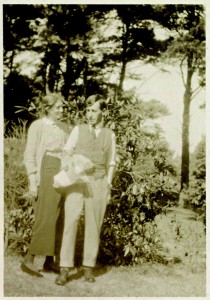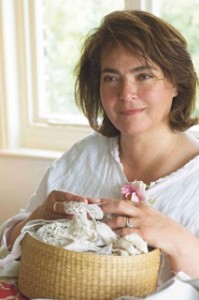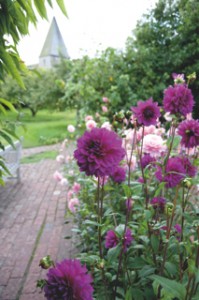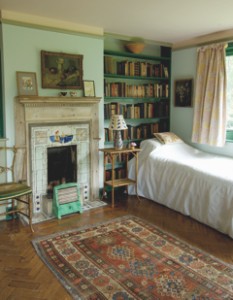Virginia Woolf’s Garden: An Intimate View
Posted in Shop/Book Reviews on December 23 2013, by Joyce Newman
Joyce H. Newman holds a Certificate in Horticulture from The New York Botanical Garden and has been a Tour Guide for over seven years. She is a blogger for Garden Variety News and the former editor of Consumer Reports GreenerChoices.org.

For gardeners and those who love Virginia’s Woolf’s literary works, there’s a gorgeous new book with exquisite contemporary photographs, written by Caroline Zoob, called Virginia Woolf’s Garden: The Story of the Garden at Monk’s House, out this month from London publisher Jacqui Small LLP ($50.00) and available in NYBG’s Shop in the Garden.
Monk’s House in the Sussex village of Rodmell was Virginia and Leonard Woolf”s country retreat from 1919 until Virginia died in 1941. She wrote most of her major novels at Monk’s House and drew inspiration and comfort from the lush foliage and beckoning brick pathways weaving through various ‘garden rooms.’ A terrace with millstones, a fishpond garden, an Italian garden, a walled garden, and a flower walk were all created by the Woolfs over the years, starting from an overgrown three quarters of an acre behind a little house, with an orchard and an old tool shed that became Virginia’s writing room.
Author Caroline Zoob and her husband Jonathan actually lived and worked at Monk’s house for more than a decade beginning in 2000 as tenants of the National Trust, planting and tending the gardens, looking after all the buildings, and opening the house twice a week to the paying public. Their deep understanding of the place and what it feels like to physically be there makes this book very special.

Zoob also worked closely on the book with friend and photographer Caroline Arber, who visited the house and garden frequently during their tenancy and who captures its flowers, charming interiors, and architectural details in beautiful full-color photographs—with many images taken very early in the morning before the public was allowed to visit.
Together with carefully captioned archival images, maps, embroidered planting designs, and revealing quotations from the Woolfs’ writings, this book illuminates Virginia and Leonard’s loving relationship to each other and to the delightfully informal garden they created.
Zoob recently described her experience living at Monk’s House and writing the book.
Q. Were you a lover of Virginia Woolf’s books before you came to Monk’s House?
A. When we moved to Monk’s House I had read only one novel by Virginia Woolf and knew nothing about Leonard. We took the lease because we fell in love with the garden. We learned about the Woolfs over the years and we researched the garden. For me, the best part of Virginia is the person we find in her diaries and letters.
Q. In what ways did living there actually change you or both you and your husband?

A. It turned us into serious gardeners. We were amateurs with a tiny back garden—over the years we learned many tricks for managing a garden open to the public twice a week. There was a sense of purpose in looking after the house and garden, and sharing it with the visitors.
Q. What were you trying to achieve with the book?
A. Leaving Monk’s House behind was very hard after a decade. So the book was a way of wrapping it all up in a parcel, tying the knot and moving on. I also wanted people to know about the garden and even more, about the relationship between Leonard and Virginia and the way they lived their lives at Monk’s House.
Q. What are some myths and misconceptions about Virginia Woolf that you discovered while living there?
A. There’s the myth that Virginia was this serious, depressed, mad person as portrayed for instance in the film The Hours. She had periods of illness. She was intense about her work. In between she was funny, she liked to cook and eat good food (tiny bites of it), bake bread, make honey, browse in antiques shops, wonder what colors to paint her house, muse about wearing red lipstick and she adored driving around in her motor car looking at houses.
Q. Was the book fun to write? How long did it take you?

A. It was fun to sort out all the information that we acquired over 10 years and to work out how to structure the book. We decided to introduce the garden rooms so that they appear in order of their creation. This dovetails with the biographical details about the Woolfs. Because I used Virginia’s diaries and letters as my main source while writing I had three very intense months with Virginia—and possibly found another aspect of her life to write about.
Q. Did you do all the archival photo research yourself? They are such wonderful images, as are the recent photographs.
A. Yes. Some of the images are very well known, but many are not and in fact most are available online through the Monk’s House albums. It was very satisfying to be able to recognize, even in very blurry images, the corners of the garden. I was particularly pleased to find the photograph taken by Maynard Keynes of Leonard and Virginia—it is so tender and affectionate.
All images courtesy of:
Virginia Woolf’s Garden: The Story of the Garden at Monk’s House
by Caroline Zoob. Photography by Caroline Arber.
By permission of the publisher Jacqui Small LLP.
Image of Virginia and Leonard used with the kind permission of the Keynes family.

